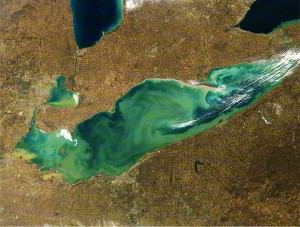A new report aimed at Great Lakes policymakers calls for Lake Erie total phosphorus reductions almost 50 percent greater than previous recommendations. Recent total phosphorus reduction recommendations may not reduce hypoxia (low dissolved oxygen) as called for by the Great Lakes Water Quality Agreement undertaken by Canada and the United States.

Reducing total phosphorus loading is a key management tool for controlling eutrophication (nutrient enrichment that over-stimulates aquatic plant growth) and hypoxia. During the 1960s and 1970s, increased total phosphorus inputs degraded Lake Erie water quality and reduced the lake’s bottom water oxygen levels. In response to total phosphorus load reductions, initiated in 1972, Lake Erie water quality quickly improved. However, since the mid-1990s, changing farming practices, invasive mussels, and climate change have allowed increased cyanobacteria blooms, macroalgae growth, and hypoxia.
The NCCOS-sponsored project, led by the University of Michigan’s Graham Environmental Sustainability Institute and involving scientists from the NOAA Great Lakes Environmental Research Laboratory,synthesized research addressing Lake Erie re-eutrophication and hypoxia. The team found that reducing the hypoxic area in the center of the basin to 1990s levels (about 780 square miles) requires cutting total phosphorus loads much more than anticipated: total phosphorus loads by 46 percent and dissolved reactive phosphorus – the type most used by algae – by 78 percent. The study was published in the Journal of Great Lakes Research .
For more information, contact Elizabeth.Turner@noaa.gov.
